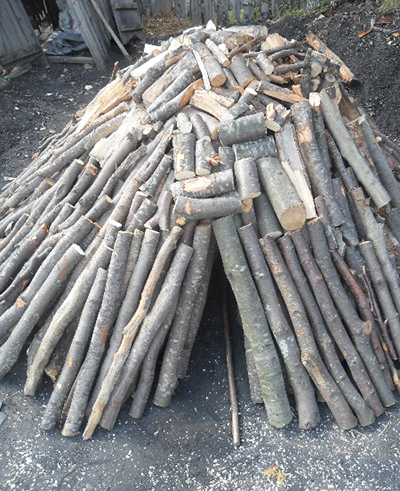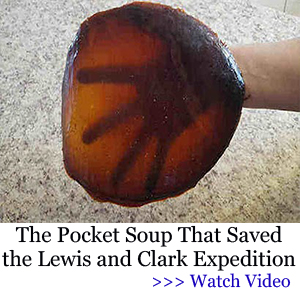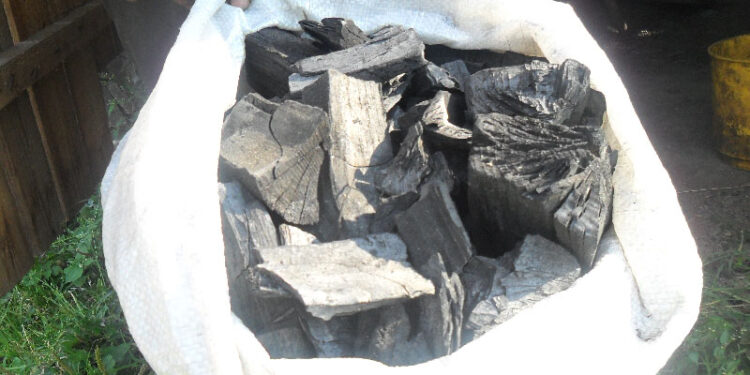This autumn, when I was backpacking across Rockies, I was surprised to see that increasingly more people stick to their traditional way of producing goods. Somewhere near the end of my journey, in Montana, near the Glacial National Park, there is a small city called Kalispell. Here, looking for a place to fix a flat tire we ran into a guy called Peter White, locally famous for being one of the best craftsmen in the area. At his workshop we found a very large backyard and lots of tools, tires and debris. For sure we were not his first costumers and fixing flat tires was not the only thing he was good at.
While he was fixing our tire, two men were loading 20-25 bags of charcoal into a van. We soon found out that they were buying homemade charcoal from Peter and they were supplying one of the best traditional restaurants in the area.
Peter allowed us to stay and watch while he was making the fire for the next round of charcoal. Finally he shared with us some of his secrets:
“First of all the wood that we want to turn into coal has 100% to be beech wood. The wood is thick, so I pile out higher and higher. In the middle of the pile of wood, I carefully placed pear-shaped, place dry twigs sprayed with oil. Even if it seems small, with only five feet tall it will produce enough charcoal to fill 30 very big bags.”
“Once completed, the pyre cover with scrap feed horses gathered from the manger, and doused with water.”
“Over the entire pyre I put scrap pieces of coal that is left from previous productions or dry soil”. According to Peter, the secret of coal quality is the wood burning and smoldering – as long as the wood used is neither too dry (in which case it burns too quickly) but not too green (in which case it would melt because of the heat).
Resulting coals are then placed in bags like the one below and store. From the last production Peter produced 30 bags, each bag worth 10$.
After completing the pyre, Peter lighted the fire in the middle. The fire has to burn for three days. He is actually keeping the fire under control: not to burn the beech wood, to have enough oxygen to smolder, not to stop the fire and not to start a fire.
Today I remembered about Peter and I wanted to share with you this traditional way of producing your own coal. I hope this information will help you some day, maybe make your own charcoal or sell it to others.
Of course this information may be very, very useful in a major SHTF situation. Charcoal may be one of the most important exchangeable goods. You may trade it for other resources you can’t procure. Knowing how to make it may prove fatal for your survival. Charcoal may also help you:
– Easily transport fire from a place to another;
– Helps filtering water;
– Writing;
– Reach temperatures higher enough to melt iron for producing weapons (Compared to wood, which burns slowly and develop a much smaller amount of heat, charcoal is a superior form of fuel, capable of producing energy for melting metals. Therefore, it was used in metallurgy as a base material for more than 3,000 years, until the end of the eighteenth century, when the growing demands of metal and wood shortages led to the replacement of fossil coals)
– Easily light up (maintain) a fire;
– Medicinal activated charcoal has become the treatment of preference in medicine; treating poisoning or overdose after oral ingestion, even more effective than classical methods like washing or pumping the stomach; it is also used to treat diarrhea.
– Smoking meat because it contains fungistatic substances that inhibit the growth of germs, mold or fungi on the surface of the meat, leaving at the same time, a good taste.
After a little search on the web I found out more about other traditional ways of producing coal. Some of them easier in some ways then Peters, but unlike his pyre, all other methods needs special tools. Tools you may not have or find in a SHTF situation. Please find below my top 3:
3. Josh Chapman charcoal producing tutorial (using two iron barrels):
2. Amy Smith charcoal briquettes from agricultural waste
1. The Charcoal Burners producing tons of charcoal
What are the other uses of coal/charcoal? Please share with us in the comment area.
You may also like:
 Veggies You Only Plant Once And Harvest Forever
Veggies You Only Plant Once And Harvest Forever
10 Things Cowboys Carried With Them in the Wild West to Survive (Video)
What Really Happens When You Only Eat Walmart Cans For 30 Days?















can you use corn stalks to make charcoal
Any dry plant materials from trees, garden waste to dry seaweed could work. Rather than casava paste any starchy paste from potato startch or corn starch to wallpaper paste or flourmixed with water to make a paste wether raw or cooked as long as it is well mixed into the crushed chared plant material then formed and pressed as illustrated then dried. Great tutorial. Necessary product for water treatment, intestinal problems, forge heating for blacksmithing and steal making or tempering.
People do NOT use treated wood for charcoal unless you are using it strictly in a forge or other non food uses. Even then exposure to the fumes could cause you injury or death.
Does anybody know why Peter uses only beech?
Lucy; The wood is thick and makes the best Charcoal?
I know, that Charcoal saved my life as an infant.
This is in Europe. 72 years ago. oops? lol I was dying as infant, with bloody diarrhea,and very weak. My grand mother stood by the crib and kept saying,”NOW SHE’S GOING TO DIE!” Did not help my mother,,right? Well, they called a doctor, finally, and he prescribed, “TIREN KOLAN” Animal charcoal. They put that,in some formula, as last resort, and I started gaining weight. I assume the diarrhea, stopped too. So, I am living proof, this stuff works!
Back then, people did not call the doctor, It was survive or die, with homemade products. They would call a doctor for an ANIMAL, but not human, because animals were so useful for survival. Of course,I am happy, they spent some money, got a Doctor, to save my life. This was right after ww2.
I, also would like to know more about (details) making the beach or other wood charcoal and also making activated charcoal. I have time to practice these methods this year nd will assuredly do so. Thanks.
I take two metal cans about those used to can beans and tomatoes. One has to be slightly larger then the other. Yhe Smallest goes on the bottom and the one on the top has a small hole in the bottom so as to allow a small amount of smoke to escape.
In the smaller can is put burnt matches and I then put the larger can down over the bottom can and and then I set both onto a grill or onto a fire. and once the smoke is almost out I remove both can’s from the fire to cool. When cool I remove the top can from the smaller can and empty the contents which is Charcoal.
I would like to know more about the 2 can charcoal I need more explanation.
what is “ACTIVATED” charcoal … ?
how is it activated … ?
how does it differ from Non-Activated charcoal … ?
bill->activated is the one you get when you put the charcoal materials in a metal boks/can with a small hole to prevent setting the material on fire witch will give you non activaded. the small hole in the lid or where ever on the boks is where the gases escape when heated and prevent over pressure, when smoke stops you take the boks out of the fire, let cool, and viola, activaded charcoal. just remember that if you are going to use it for internal issues, use clean materials. i heard coconutshell is great for use.
Activated carbon is takes the normal charcoaling process additional steps to produce increased surface area over the standard charcoal.
Per Livescience.com,
“The charcoal powder is then typically charred with some additional material, such as chloride salts, to help create the porous structure, according David O. Cooney’s book “Activated Charcoal: Antidote, Remedy and Health Aid” (TEACH Services, Inc., 2016). The excess material is then washed away with a dilute acid solution to leave the pure carbon. The charcoal can further be treated to create a finer network of pores, and therefore additional surface area, by exposing it to an oxidizing gas, such as steam or carbon dioxide.
So much additional surface area is created during the activation process that 50 grams of activated charcoal (which is about the weight of 20 U.S. pennies) has 17.5 times more surface area than a full-size football field
Activated charcoal means heating regular charcoal to a high temperature, so it expands forming a soccer ball type structure, this is what allows the absorption of toxins.
For human-animal consumption, I think it’s better to just buy it in bulk online and a manual capsule filling machine if you want it in capsule form, otherwise just mix with water and be careful not to inhale any of it. Do not spill it on anything, as the fine powder sticks and impregnates everything.
“Knowing how to make it may prove fatal for your survival.” Taken directly from above narrative.